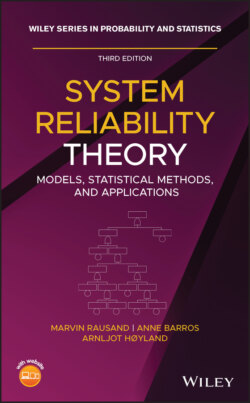Читать книгу System Reliability Theory - Marvin Rausand - Страница 94
2.7 Simple, Complicated, and Complex Systems
ОглавлениеMost modern books on reliability theory and analysis seem to be concerned with “complex systems,” but (almost) none of them define what they mean by the term complex. In our understanding, we may classify a system into one out of three categories:
Simple systems. A simple system is easy to understand and can be analyzed by following a defined procedure or algorithm. Most simple systems have a rather small number of components. Simple systems can generally be modeled by a series–parallel RBD (see Section 2.8).The Newtonian–Cartesian ParadigmA paradigm is a worldview underlying the theories and methodologies of a scientific subject. For system reliability, the Newtonian–Cartesian paradigm has been, and still is, the most essential. The basis for this paradigm was made by the French philosopher and scientist Réne Descartes (1596–1650) and the English mathematician and physicist Sir Isaac Newton (1642–1726).The paradigm is based on Newton's three laws of forces and motion, his theories on universal gravitation, and the unifying theory that is called Newtonian mechanics. Another important basis for the paradigm is Descartes' theory of reductionism and his division between mind and matter, between mental and physical processes. Reductionism implies that any system (or problem) can be adequately understood by reducing it, or decomposing it, to a set of its constituent components and by carefully and individually studying each component. When all the components on the lowest level have been carefully studied, a synthesis process can be started. By combining the knowledge about the components that feed into a module on the upper, next level, the paradigm implies that all important properties of this module can be deduced from the properties of its constituent components. This is then continued until the system level is reached (see Figure 2.7).The Newtonian–Cartesian paradigm sees the world as a number of discrete, unchanging objects in an empty space. These objects interact in a linear, cause and effect manner. The time is linear and universal and not affected by speed or gravitation. The system behavior is deterministic, such that a particular cause leads to a unique effect. The paradigm supports the analysis of systems with a finite number of (mainly) independent parts that interact in a well‐defined manner with relatively few interconnections.The Newtonian–Cartesian paradigm is also called the Newtonian paradigm and the mechanistic paradigm.The Newtonian–Cartesian paradigm has had an enormous success and most of our current knowledge about physical systems are based on this paradigm. Much more information about the Newtonian–Cartesian paradigm can be found by visiting a good library or searching the Internet.
Complicated systems. A complicated system has a high number of components with a fair degree of interrelationships and interdependencies between the components. By using current knowledge (e.g. by involving subject experts), we are able to understand the relevant system properties and to analyze it.
Complex systems. In a complex system, the behavior of at least some of the components or the interactions between them do not comply with the requirements of the Newtonian–Cartesian paradigm. A complex system cannot be adequately understood and analyzed by traditional approaches because the system is something more than a sum of its components.
Figure 2.7 System analysis and synthesis.
An emergent property is a system property that cannot be deduced from the properties of the system components. In many cases, emergent properties lead to unexpected system behavior that may be dangerous. A system is usually not designed or built to be complex, but may develop into a complex system through changes, coupling, and emergence.
There is a considerable disagreement about how to delimit the concept of emergence. Some authors interpret emergence very widely and say that “properties” such as reliability, quality, and safety are emergent properties of a system.
Simple and complicated systems can be studied based on the Newtonian–Cartesian paradigm, whereas complex systems cannot be adequately studied within this paradigm. A new worldview called the complexity paradigm is therefore being developed.
All the examples in this book are related to simple systems, but the theory and methods presented may also be applied to complicated systems and many aspects of complex systems. Complex systems as such are not studied in this book.
